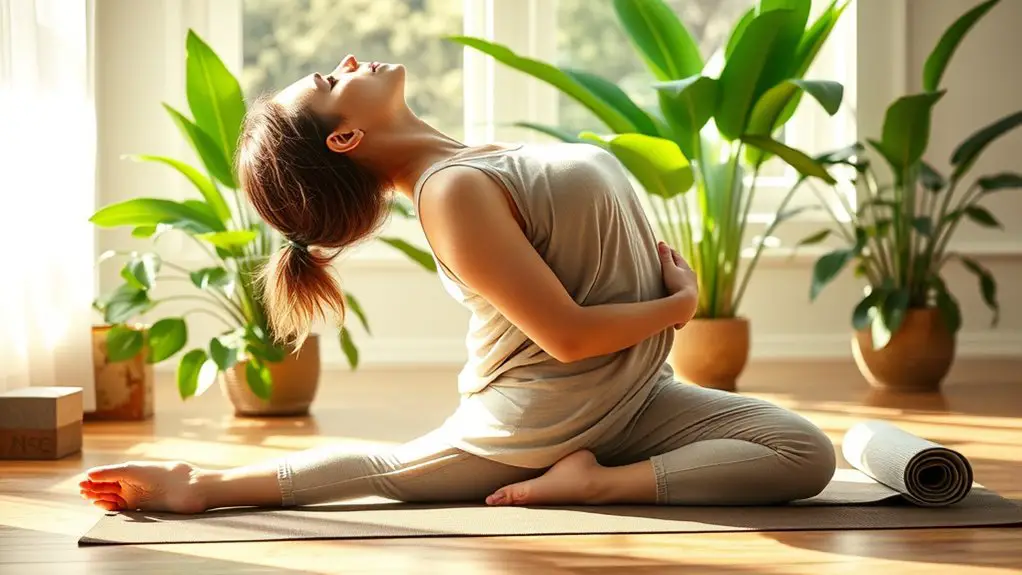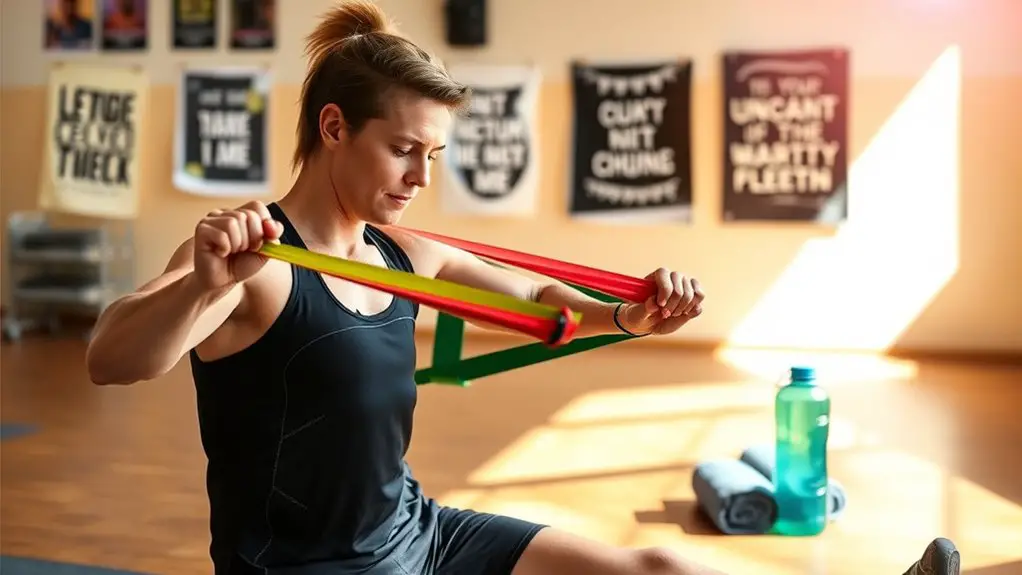For effective muscle recovery, you can try Child's Pose, which eases tension, or Downward-Facing Dog that stretches and promotes circulation. Pigeon Pose targets hip flexors, while Cat-Cow Stretch warms up the spine. Don't forget the Supine Spinal Twist for back relief and flexibility. Each pose encourages deep breathing and relaxation, perfect for rejuvenation. You'll discover even more helpful poses to enhance your recovery journey as you explore further.
Child's Pose
When you're looking to unwind and ease muscle tension, Child's Pose is a perfect choice. This gentle pose invites you to sink into yourself, allowing your body to relax and your mind to release the day's stresses. As you kneel on the mat, let your hips settle back toward your heels, stretching your arms forward and resting your forehead gently down. Feel the soothing connection with the earth, encouraging deep breaths that invite peace and freedom. It's a moment to listen to your body, acknowledging any tightness or fatigue. Child's Pose not only calms your mind but also helps stretch the spine, hips, and thighs, making it an essential part of your recovery journey. Embrace this time for yourself.
Downward-Facing Dog
Downward-Facing Dog is a foundational pose that can greatly aid in muscle recovery. It stretches your hamstrings, calves, and spine, helping to release tension built up from workouts. As you press your palms and heels into the ground, you'll feel a rejuvenating sense of freedom flow through your body. This pose encourages deep breathing, allowing you to reconnect with your inner self and find balance. It also promotes blood circulation, which speeds up recovery by delivering nutrients to sore muscles. To get the most out of it, focus on lengthening your spine and engaging your core. Remember, it's about finding your rhythm and embracing the moment, so let go of any stress and enjoy the release.
Pigeon Pose
Pigeon Pose is a powerful stretch that targets the hip flexors and glutes, making it an excellent choice for muscle recovery. When you sink into this pose, you're not just stretching; you're releasing tension and inviting freedom into your body. Picture yourself:
- Opening your hips like a flower blooming, allowing for a deeper breath and a sense of lightness.
- Feeling the ground beneath you, providing stability, while your body unwinds and relaxes.
- Embracing the release of tightness, as you let go of what no longer serves you.
In this pose, you'll find both strength and softness, helping you to reconnect with your body and restore balance after intense workouts. Let Pigeon Pose guide you towards recovery and rejuvenation.
Cat-Cow Stretch
After releasing tension in your hips with Pigeon Pose, it's time to warm up the spine with the Cat-Cow Stretch. This dynamic movement invites freedom into your back, helping to relieve stiffness and promote circulation. Start on all fours, hands under your shoulders and knees under your hips. Inhale, arching your back gently, letting your belly drop and your head lift—this is Cow Pose. Exhale, rounding your spine, tucking your chin to your chest, and pressing into your hands—here's Cat Pose. Flow between these two positions, syncing your breath with each movement. Feel the rhythm and release any remaining tension. This stretch not only enhances flexibility but also encourages a sense of ease and openness throughout your entire being.
Forward Bend
As you shift from the Cat-Cow Stretch, incorporating Forward Bend into your routine can deepen the release in your back and legs. This pose invites you to let go and surrender, creating space for freedom.
To enhance your experience, focus on these three elements:
Enhance your Forward Bend by focusing on breath, weight, and relaxation for a deeper, freeing experience.
- Breath: Inhale deeply, feeling your chest lift, then exhale as you fold forward, letting go of tension.
- Weight: Shift your weight onto your heels, grounding yourself while allowing your spine to lengthen.
- Relaxation: Let your head hang heavy, releasing any thoughts that weigh you down.
With each Forward Bend, you're not just stretching; you're reconnecting with your body, embracing freedom in every fiber.
Supine Spinal Twist
The Supine Spinal Twist is a powerful pose that brings relief to your back while promoting flexibility. As you lie on your back, draw one knee toward your chest, then let it fall across your body. This gentle twist opens up your spine, releasing tension and inviting a sense of freedom. You'll feel the stretch through your lower back and hips, enhancing circulation and aiding recovery.
Breathe deeply here; each inhale fills you with energy, while each exhale helps you let go of stress. Switch sides to guarantee balanced relief. Incorporating this pose into your routine can rejuvenate your body, allowing you to move through life with greater ease and grace. Embrace the release and enjoy the journey toward deeper relaxation.
Legs-Up-the-Wall Pose
Legs-Up-the-Wall Pose is a restorative gem that promotes relaxation and rejuvenation. It's perfect after a long day or an intense workout, allowing you to reset and find your center. Here's how to enjoy its benefits:
Legs-Up-the-Wall Pose is a restorative practice that helps you unwind and recharge after a busy day or workout.
- Feel the gentle stretch: As you elevate your legs, feel the soothing release in your hamstrings and lower back.
- Breathe deeply: Inhale tranquility and exhale tension, letting go of the day's stress as you settle into the pose.
- Connect with your body: Embrace the stillness, allowing your mind to wander freely while your body restores its energy.
Frequently Asked Questions
How Often Should I Practice These Poses for Recovery?
You should practice these poses regularly, ideally a few times a week. Listen to your body's needs—if you feel tight, do more. Remember, it's about finding balance and freedom in your recovery journey.
Can I Do These Poses After a Workout?
Absolutely, you can do these poses after a workout! They're great for easing tension and promoting flexibility. Just listen to your body and let it guide you through the movements for ideal recovery.
Are These Poses Suitable for Beginners?
Absolutely, these poses are perfect for beginners! They're designed to be accessible, helping you ease into your practice. Just listen to your body, and don't hesitate to modify any pose to suit your comfort level.
How Long Should I Hold Each Pose?
"Good things come to those who wait." When you're practicing, aim to hold each pose for around 30 seconds to a minute. This duration lets your body relax and truly embrace the freedom of movement.
What if I Feel Pain During These Stretches?
If you feel pain during stretches, it's important to listen to your body. Don't push through discomfort; adjust your position or take a break. Freedom in your practice means honoring your limits and finding comfort.




